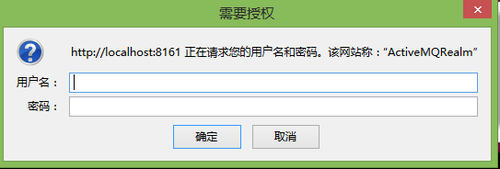ActiveMQ的安裝、運用
1、下載ActiveMQ:http://activemq.apache.org/
2、解壓包,並找到activemq.bat,雙擊打開一個控制臺,跟你打開tomcat一樣的。如圖:

3、在瀏覽器查看你的activemq是否正確啟動:http://localhost:8161/admin,打開之後看到這樣:

用戶名:admin 密碼:admin
確定即可登錄。
4、你可以新建一個Queue,在 Queue Name後面的方框中填入“MyFirstQueue”,點擊正後方“Create”按鈕即可。

在下面Queues:列表中,就會顯示你剛剛新建的Queue:
 這是已經使用過的,其實一開始數值是這樣的:
這是已經使用過的,其實一開始數值是這樣的:
Name : MyFirstQueue
Number Of ending Message : 0
Number Of Consumers :0
Message Enqueued:0
Message Dequeued:0
5、接下來我們通過IDEA來創建兩個java類,一個是消息生產者,一個是消息消費者。
這是消息生產者:
package com.zfm.activemq;
import org.apache.activemq.ActiveMQConnection;
import org.apache.activemq.ActiveMQConnectionFactory;
import javax.jms.*;
public class Sender {
private static final int SEND_NUMBER =5;
public static void main(String[] args){
//ConnectionFactory:連接工廠
ConnectionFactory connectionFactory;
//Connection:JMS客戶端到JMS Provider的連接
Connection connection = null;
//Session :一個會話,發送或接收消息的線程
Session session;
//Destination:消息的目的地
Destination destination;
//MessageProducer:消息產生者:發送
MessageProducer messageProducer;
//構造connectionFactory實例對象
connectionFactory = new ActiveMQConnectionFactory(
ActiveMQConnection.DEFAULT_USER,
ActiveMQConnection.DEFAULT_PASSWORD,
"tcp://localhost:61616"/*ActiveMQ默認使用的TCP連接端口是61616,*/
);
try{
//構造從工廠得到的連接
connection = connectionFactory.createConnection();
//啟動
connection.start();
//獲取操作連接
session = connection.createSession(Boolean.TRUE,
Session.AUTO_ACKNOWLEDGE);
//獲取session的參數
destination = session.createQueue("FMDemo");
//得到消息生成者
messageProducer = session.createProducer(destination);
//設置·不持久化
messageProducer.setDeliveryMode(DeliveryMode.NON_PERSISTENT);
//構造消息
sendMeaasge(session,messageProducer);
session.commit();
}catch (Exception e){
e.printStackTrace();
}finally {
try{
if(null!=connection){
connection.close();
}
}catch (Throwable t){
}
}
}
public static void sendMeaasge(Session session,MessageProducer producer) throws JMSException {
for(int i=1;i<=SEND_NUMBER;i++){
TextMessage message = session.createTextMessage("ActiveMq 發送的消息" +i);
//發送消息到目的地
System.out.println("發送消息: ActiveMq發送消息:" + i);
producer.send(message);
}
}
}消息消費者:
package com.zfm.activemq;
import org.apache.activemq.ActiveMQConnection;
import org.apache.activemq.ActiveMQConnectionFactory;
import javax.jms.*;
public class Receiver {
public static void main(String[] rags) throws JMSException {
//Connection連接工廠
ConnectionFactory connectionFactory;
//Connection:JMS客戶端到JMS provider
Connection connection = null;
//Session : 一個發送或接受消息的·會話
Session session;
//Destination:消息的目的地,消息發送給誰
Destination destination;
//消費者,消息接收者
MessageConsumer messageConsumer;
connectionFactory = new ActiveMQConnectionFactory(
ActiveMQConnection.DEFAULT_USER,
ActiveMQConnection.DEFAULT_PASSWORD,
"tcp://localhost:61616"//ActiveMQ默認使用的TCP連接端口是61616,
);
try{
//從構造工廠裏獲得連接
connection = connectionFactory.createConnection();
//一定要啟動
connection.start();
//從連接獲得會話
session = connection.createSession(Boolean.FALSE
,Session.AUTO_ACKNOWLEDGE);
destination = session.createQueue("FMDemo");
messageConsumer = session.createConsumer(destination);
while(true){
//設置接收者接受新消息的時間
TextMessage message = (TextMessage)messageConsumer.receive(100000);
if(null!=message){
System.out.println("收到消息" + message.getText());
}else{
break;
}
}
}catch (Exception e){
}finally {
try{
if(null != connection) {
connection.close();
}
}catch(Throwable t){
}
}
}
}當運行Sender.java之後,刷新http://localhost:8161/admin/queues.jsp時,
Queues表中的參數有變化咯:
Name : MyFirstQueue
Number Of Pending Message :5
Number Of Consumers :0
Message Enqueued :5
Message Dequeued :0
此時,由於消息已經發完,並且我們沒有讓Sender的main函數一直運行,所以,在控制臺打印了:
發送消息: ActiveMq發送消息:1
發送消息: ActiveMq發送消息:2
發送消息: ActiveMq發送消息:3
發送消息: ActiveMq發送消息:4
發送消息: ActiveMq發送消息:5
Process finished with exit code 0
進程結束了。
這時我們再運行Receiver.java,而後控制臺打印:
收到消息ActiveMq 發送的消息1
收到消息ActiveMq 發送的消息2
收到消息ActiveMq 發送的消息3
收到消息ActiveMq 發送的消息4
收到消息ActiveMq 發送的消息5
Process finished with exit code 0
此時,再刷新http://localhost:8161/admin/queues.jsp,此時表格數值變為:
Name : MyFirstQueue
Number Of Pending Message :0
Number Of Consumers :0
Message Enqueued :5
Message Dequeued :5
還有一點是:當Receiver.java並沒有運行結束的時候,由於我只開啟了一個Receiver進程,所以這時Number Of Consumers:1。
可見,由Sender發出的消息已經被Receiver收到了。你可以先把Sender消息發出來,這個時候只要消息已經到消息隊列上了,只要你不期望發送者還要接收什麽回復,你就可以把Sender停掉了。Receiver還是一樣的接收到信息。
下面介紹一下ActiveMQ的幾種基本通信方式:發布-訂閱模式和點對點模式。
基礎流程:
1、獲得ActiveMQConnectionFactory。
2、利用factory獲得Connection。
3、啟動connection。
4、通過connection創建Session。
5、指定Session的Destination。
6、發送消息者則創建MessageProducer/接收消息者創建MessageConsumer。
7、發送和接收JMS Message。
8、關閉所有JMS資源。
ActiveMQ詳情見http://shmilyaw-hotmail-com.iteye.com/blog/1897635
講到ActiveMQ,其實他是java消息服務(JMS)的其中一種規範,JMS詳情見:http://blog.csdn.net/jiuqiyuliang/article/details/46701559 和 http://blog.csdn.net/jiuqiyuliang/article/details/47160259。
什麽情況下使用ActiveMQ?
多個項目之間集成
(1) 跨平臺
(2) 多語言
(3) 多項目降低系統間模塊的耦合度,解耦
(1) 軟件擴展性系統前後端隔離
(1) 前後端隔離,屏蔽高安全區
ActiveMQ的安裝、運用
